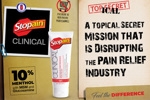
Ready, Set,..Ouch!!! Help Y...
VIEW >

A Topical Secret Mission th...
VIEW >

Not yet a Pro Portal member? Sign up here.
Chiropractors, Physical Therapists, Massage Therapists and other Hands-On Healthcare Professionals are an essential health and wellness resource for individuals of all ages. We partner closely with these professionals on helping people perform better and move ‘pain-free’.
Our topical pain relief products were specifically formulated with these hands-on healthcare professionals (and their patients) in mind. Our fast-acting formulation with penetration enhancers plus 10% menthol, MSM, Glucosamine is like no other. Embracing hands-on healthcare professionals and topical pain relief solutions like Stopain® Clinical provides patients and their families with the ultimate wellness solution.
Visit our clinic locator to find a healthcare professional in your community.

Patients enjoy and take advantage of a wide variety of topical products in my office for pain relief. The results I see using topical creams on my patients has to do with the products physiochemical properties, the dose frequency patients apply, and the mechanism(s) of action to penetrate the layers of epidermis.
Sometimes I want something that has an anti-inflammatory effect, and sometimes I want something that decreases pain sensation levels — sometimes I need both!
Getting topical with pain
Topicals are easy to prescribe because they lack systemic side effects, are noninvasive, easily self-administered, and can be fast acting. Another big benefit of topical administration is no gastrointestinal (GI) tract issues.
People get focused on the site of their pain as if it’s the pain generator. Whether it’s placebo or not, the combination of having the patient rub a topical “something” with a cooling sensation or no sensation at all into a painful area and then having them move the painful body part (skin, fascia, muscle, joint, bone, etc.) is a true example of neuroplasticity in action.
In many of my patients the combination of a local stimulation with a topical concentration are greater than taking a pill with systemic effects and has allowed me to help patient’s lower oral analgesic consumption.
Topical + rubbing action + movement = mind changing brain structure Hemp-derived cannabis topicals and menthol-based products fulfill all the above and have millions and millions of applications without adverse effect.
Topicals act locally in the layers of epidermis and dermis. Very little if any gets absorbed systemically into the bloodstream. Surprisingly, topical products, i.e. CBD, do not absorb very well, since the skin is not very permeable. If you want to use topical treatments to deliver pain relief that is localized to the affected area, then you must consider particle size. Particle size affects the degree to which the product may be physically irritating when applied; generally, smaller particles are less irritating.
Counterirritant and CBD
Counterirritants are the most commonly recommended topical for pain relief. Their ingredients (usually menthol or camphor) work by irritating the skin, causing the sensation of burning or tingling.
Most patients interpret this sensation as the topical working to relieve their pain, when in reality it is simply distracting them from the pain underneath. In order to optimize the performance of a topical pain analgesic, you need to ensure that the menthol and other ingredients are getting to the inflammation and pain site quickly. This is achieved by formulating a product with the correct ratio of quality ingredients that are designed to work in conjunction with each other.
As Robert Topp, et al, stated in the paper, “Topical Menthol Gel versus a Placebo Gel on Post-manipulation Pain and Range of Motion in Patients with Mechanical Neck Pain,” “Topical application of menthol may be effective in mitigating pain immediately post cervical manipulation and is accompanied by a low risk of adverse effects. Topical menthol application before manipulation may reduce neck pain, but it has no measurable effect on neck range of motion following cervical manipulation among patients with mechanical neck pain.”
Dose and frequency for layers of epidermis permeation
For topical products to have biologic effects, the active ingredients must first enter the body. I do that in the office by introducing the product and applying the first dose of the topical.
Next I need the patient to follow up with “on your own” applications to keep delivering another sensation (counterirritants such as warming effect or cooling effect) and/or to achieve an appropriate concentration of hemp-derived cannabis for an anti-inflammatory effect. I can’t get a topical to cross the stratum corneum of the skin unless the patient understands dose and frequency of application to do on their own.
Topical skin permeation rates have been measured in experimental models of human skin. Studies by Paudel, et al, and Lodzki, et al, demonstrate topical penetration of cannabinoids into the animal bloodstream. The Lodzki study describes the ability of a topical cannabinoid preparation to penetrate through the layers of epidermis all the way through and into the underlying muscle tissue. This is important to us because relief of muscles soreness is one of the most commonly reported effects of topical cannabinoids, including tetrahydrocannabinol (THC) and cannabidiol (CBD).
Some cannabinoids have higher barriers to penetration than others. In animal models, for example, CBD has been shown to cross the skin barrier much more easily than delta-8-THC does, by a 10-fold factor. Additionally, CBD is more easily absorbed through skin compared to cannabinol (CBN), another common cannabinoids.
Deep skin penetration and local tissue penetration
Carrier ingredients in a product, such as ethanol, can enhance topical penetration across the skin. Additionally, and importantly, in animal models, a more concentrated topical has yielded better experimental results than those with lower cannabinoid content, suggesting that topical effects are concentration dependent.
A topical behemoth brand in the retail sector (and chiropractic space) and a friend to all body workers across health care professions was sold recently to a large international company. This familiar company brand and others like it contain various levels of menthol.
We have all felt the cooling effects of menthol. Just get this product on the skin and the patient will feel some cooling or tingling effect (counterirritant). Other brands contain proprietary ingredients such as camphor, tumeric, arnica, Pycnogenol, glucosamine and MSM (methylsulfonylmethane).
If I need deeper penetration of the layers of epidermis, I need enhancers and other chemicals designed to promote ease of application. Without penetration we will not see the anti-inflammatory effect, i.e. CBD products.
Product smell and inactive ingredients
Attractiveness of the final product to my patients often depends on the smell of the product.
Complementary ingredients in topicals include terpenes. These are aromatic organic hydrocarbons found in the essential oils of plants. They produce the distinct aroma associated with each plant, which is not only thought to protect the plant, but to offer therapeutic benefits. Menthol and camphor are the two most widely used active pharmaceutical ingredients in topical pain management today.
The terpene molecules (C10H16) produce analgesic action in neuropathic pain by decreasing neuronal excitability through peripheral mechanisms. Terpenes like eucalyptus, clove and peppermint can be combined with the active ingredients to create a synergy effect with the other natural ingredients for optimal benefits.
Excipients are frequently called “inactive” ingredients — they ultimately affect the quality, safety, and potential effectiveness of a compounded preparation by affecting solubility, stability, release of the active ingredient, and skin penetration. Excipients also have the potential to interact with other ingredients.
Skin cannabinoid receptors
Approximately 90% of the skin cells (keratinocytes) contain cannabinoid (CB1 and CB2) receptors and transient receptor potential channel vanilloid-receptor (TRPV), expressed on central and peripheral terminals of primary sensory neurons. TRPV is a molecular pain target for analgesics.
When considering topicals:
Experience demonstrates that the feeling of menthol and camphor topical applications change with temperature of the skin when it is applied. Physical therapies that increase temperature (laser, TECAR (Transfer of Energy Capacitive and Resistive), etc.) versus those that decrease it (cold therapy, ice packs) may explain patient preference.
Pain within local tissue that has produced a wide range of inflammatory substances requires sensitizing the sensory nerves. On top of my multimodal treatment approach including hands-on therapy, powerful modalities like percussion massagers, shockwave, TECAR, laser, and electrical cupping devices, I need topicals for pain relief. The combination of using a topical with chiropractic and technology allows patients to feel better faster or recover faster than Mother Nature intended.
JEFFREY TUCKER, DC, is the current president of the ACA Rehabilitation Council and practices in West Los Angeles, Calif. He writes for Stopain Clinical and can be reached at DrJeffreyTucker.com.